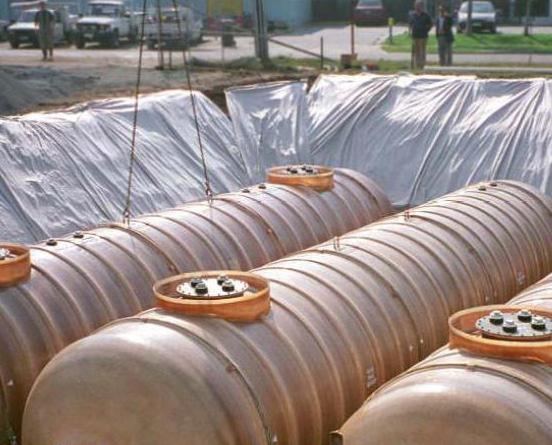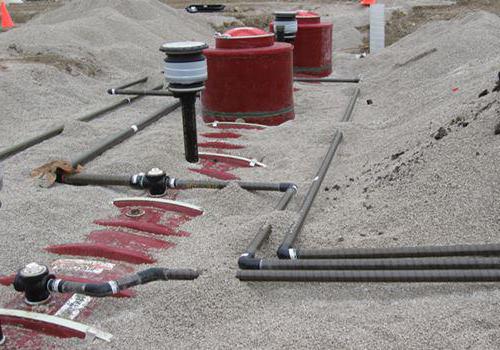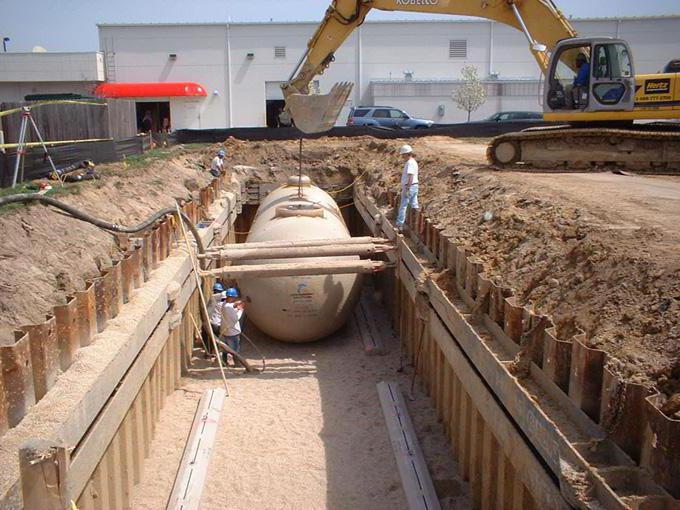An underground tank is most often used to store specific liquids in various industries. Its use eliminates the influence of external factors on the content, allowing for a long time to maintain the properties of the product.
Area of use of tanks
Underground tanks are used not only in industries, but also in the everyday life of people. They are often used as fire tanks in enterprises where there is no water source. In industry, an underground tank is used to store oil products, acids, fuels and lubricants, oils, drinking and industrial water. They are located strictly horizontally, on the basis of concrete. In the oil refining sector, the main purpose is the preservation of products obtained from oil refining. The underground location of the tank reduces the possibility of pollution of the surrounding area and protects the contents from the effects of high temperatures in the summer. Also, underground storage of containers allows you to significantly free up production space and use them with maximum efficiency.
Tank device
The underground tank is equipped with two hatches. Through one, filling and sampling of the liquid are carried out, the second is designed to inspect the tank and assess its condition. Each tank has sensors that detect temperature, pressure and fuel level. Filling or intake of liquids is carried out using special pumps equipped with explosion-proof system.
When installing an underground tank, it is taken into account that the ambient temperature can become lower than the freezing temperature of the stored fuel. In this regard, the tanks are equipped with a heating system. If they are located in the northern regions, then the pit in which the tank is located is equipped with a heating system. Also, the pit should be at a depth below the level of freezing of the soil. Such measures are necessary to maintain heat and reduce the influence of climatic conditions on the contents of the tank.
Among other things, the underground reservoir is equipped with instruments that determine the pressure, temperature and level of the liquid inside. Sample and content indicators are also available.
Kinds
The tank is a container of steel. Depending on the future content, they are available with different bottoms. The cylinder with a flat bottom is designed to store products with oil content, the pressure of which does not exceed 40 kPa. The conical bottom makes it possible to store the same combustible substances with a pressure of up to 70 kPa. Also, depending on the purpose, the tanks can be single-walled or double-walled. The former are most often used for storing industrial or drinking water. Double-walled tanks are used for aggressive liquids.

Installation of underground tanks from steel for water storage allows to reduce fluid loss due to the influence of solar radiation, reduces heat loss, and also due to the underground location allows rational use of the area of industrial enterprises. Storage tanks for petroleum products help protect fuel from external factors. It is also necessary to provide for the construction of an access road in case of an emergency and the need to pump out fuel. Underground tanks are designed to operate in temperatures ranging from -40 to +40 degrees Celsius and air humidity up to 80%.
Mounting
The tank is installed on a specially prepared site. The bottom of the pit is equipped with a sand cushion up to 30 centimeters thick and rammed with gravel. Then a layer of waterproofing is laid and the site is filled with concrete. The thickness of the concrete pad should not be less than 20 centimeters.

The height of the well depends on the height of the tank, and the layer of earth above the tank should be up to 1.2 meters. The well is covered with a reinforced concrete slab with holes for manholes. The surface of the slab must be insulated; for this, bitumen is usually used, which is applied hot to the surface. To withdraw to the surface of the tank hatches, cast iron hatches are installed in the slots of the plate , and around them wells made of bricks 2 x 2 meters are made. The surface near the wells must be equipped. To do this, a blind area is made of stone, bonded with concrete mortar, and after hardening, a layer of sand is laid. The walls of the well are also treated with liquid bitumen.

The construction of underground tanks is carried out taking into account the terrain. In this case, such factors are taken into account: maximum summer and minimum winter temperature, wind rose, maximum load of snow cover and type of soil. If there is a large percentage of groundwater in the ground, then the containers are additionally attached to the concrete base.
Tank Replacement
The operating time of underground tanks depends on the type of liquid that is stored in them, and can range from 10 to 50 years. Despite the fact that these tanks are intended for underground use, sooner or later corrosion of the metal occurs. Dismantling of the underground reservoir should be carried out by specialists using special equipment, since there is a danger of poisoning by toxic fumes and gases. The removed tank is sent for disposal, and the room in which it was located is cleaned for future use.
Benefits of Underground Tanks
Currently, tanks are in great demand due to their advantages. When using such storages, a significant place remains on the territory of enterprises, and the contents of the tanks are not exposed to external factors and retain their properties for a long time. The location of the tanks below the earth's surface allows you to protect fuel or other liquids from temperature extremes and possible seismic activity.